Master Concept Testing: 5 Steps for Effective Market Insights

Master Concept Testing: 5 Steps for Effective Market Insights
Overview
The article emphasizes the essential steps for effective concept testing, highlighting its critical role in gathering market insights prior to launching new products. It presents a structured approach that includes:
- Establishing clear objectives
- Recruiting the right participants
- Crafting targeted questions
- Synthesizing data
These features not only enhance decision-making but also significantly reduce the risks associated with product introductions. Evidence shows that effective concept testing can considerably improve the chances of successful launches.
How can these steps be integrated into your product development process? By applying this structured methodology, businesses can better align their offerings with market needs, ultimately leading to more successful outcomes.
Introduction
Concept testing serves as a pivotal strategy in market research, allowing businesses to refine their product ideas prior to launch. By gathering insights from potential buyers, companies can mitigate the risks associated with product failures. This proactive approach not only enhances market positioning through informed adjustments but also fosters a deeper understanding of consumer needs.
However, a challenge persists: how can organizations effectively navigate the complexities of concept testing to capture meaningful feedback that drives success? This guide explores five essential steps to master concept testing, equipping businesses with the necessary tools to unlock valuable market insights and elevate their product development processes.
Define Concept Testing and Its Importance
Concept testing serves as a crucial research technique for evaluating new product proposals or marketing strategies prior to their launch. This process of concept testing involves gathering feedback from prospective buyers, allowing companies to gauge perceptions, preferences, and purchase intentions. The significance of concept testing lies in its capacity to mitigate risks associated with product introductions, offering valuable insights into buyer behavior and prevailing market trends. For instance, research indicates that 85% of product introductions fail when firms neglect to engage their audience beforehand, underscoring the vital role of concept testing in refining ideas before they reach the market.
Recent advancements in idea evaluation methods, such as Ipsos' innovative digital idea assessment approach, have transformed how companies gather client perspectives. This method incorporates 'swipe-able' ideas and concise surveys, resulting in over 50% more time spent reviewing concepts. Such innovations allow companies to connect with a broader range of demographics, including hard-to-reach groups like Millennials, thereby enriching the feedback process. Additionally, the integration of AI in idea evaluation has streamlined the analysis of consumer insights, facilitating faster and more efficient decision-making. For example, Zappi's AI agents reduce resource costs for new ideas by a factor of 20, demonstrating the effectiveness of modern methodologies.
The benefits of concept testing extend beyond merely reducing risks; they also enhance market positioning. By identifying both strengths and weaknesses during concept testing early in the development phase, businesses can make informed adjustments that align with customer expectations. This proactive approach not only increases the likelihood of a successful launch but also utilizes concept testing to foster a deeper understanding of buyer behavior, which is essential in today’s competitive landscape. Experts emphasize that contemporary research techniques, which engage consumers on their terms, yield richer insights and faster outcomes, ultimately leading to improved business performance. As Amy Gallo points out, grasping the difference between statistical significance and practical significance is vital for managers, particularly as more organizations depend on data for critical business decisions. Furthermore, setting clear objectives for concept testing is essential to ensure that the insights gathered are relevant and actionable. Lastly, testing and refining surveys with a small group prior to full distribution is a crucial step in guaranteeing clarity and effectiveness in the survey process.
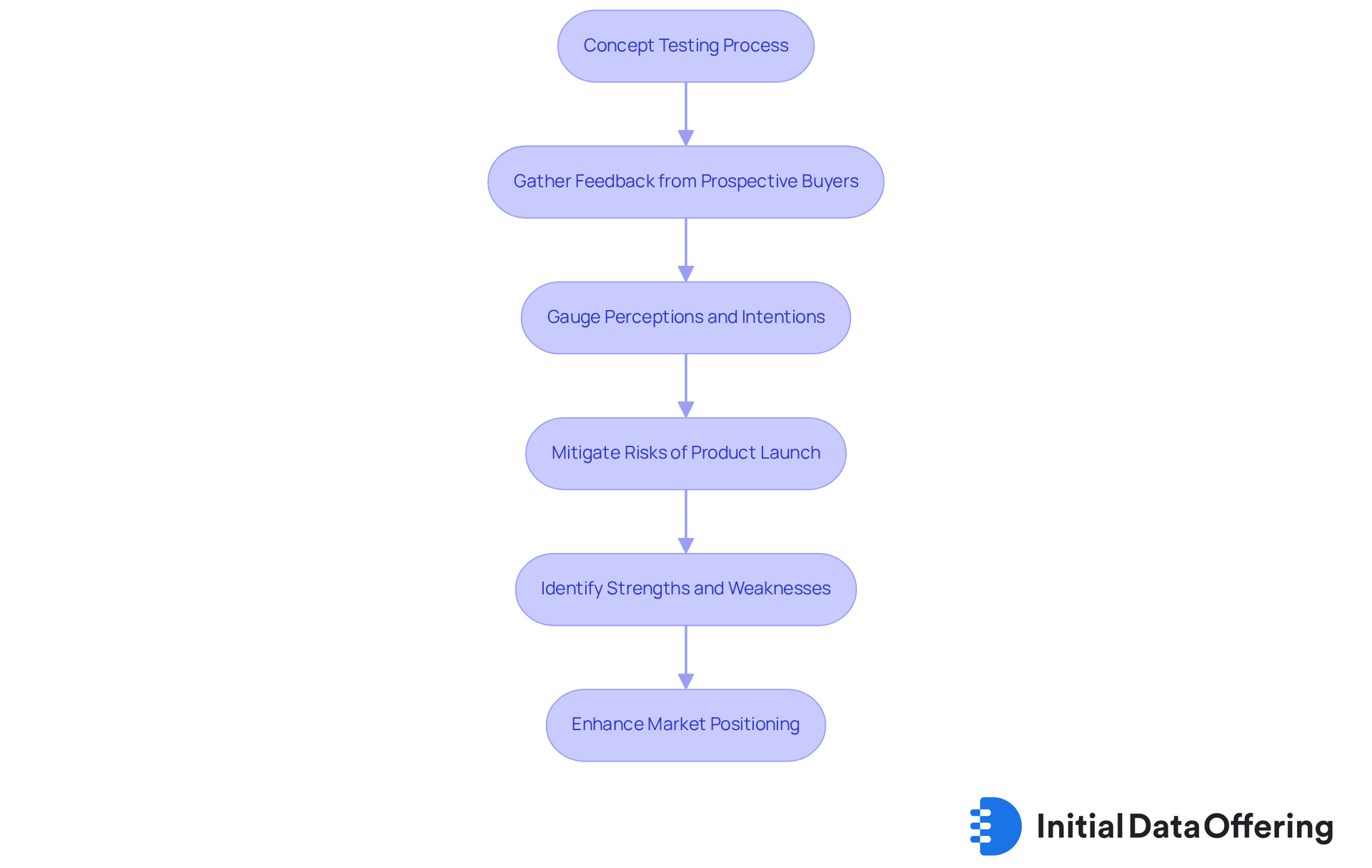
Establish Clear Objectives for Your Concept Test
To establish clear objectives for your idea test, begin by identifying the key questions you want to answer. What aspects of the idea require feedback? Consider its appeal, functionality, or pricing. Formulate specific, measurable objectives that will guide your research. For instance, you may seek to assess whether at least 70% of participants find the idea appealing or if the suggested price point is acceptable. Understanding your target audience is crucial for crafting relevant questions that reflect their preferences and behaviors. Clear objectives will not only concentrate your assessment efforts but also assist in evaluating the success of the idea through concept testing once the data is gathered.
Research from Bain & Company indicates that brands that utilize concept testing and optimize early are 1.5 to 2 times more likely to achieve successful product launches. This statistic underscores the importance of early testing in the product development process. Moreover, as Kadence International asserts, 'Concept testing seeks to confirm a product notion prior to allocating substantial resources for its development,' emphasizing the necessity of establishing measurable goals in idea evaluation. By defining these objectives, you can ensure that your concept testing aligns with broader marketing strategies and effectively addresses consumer needs.
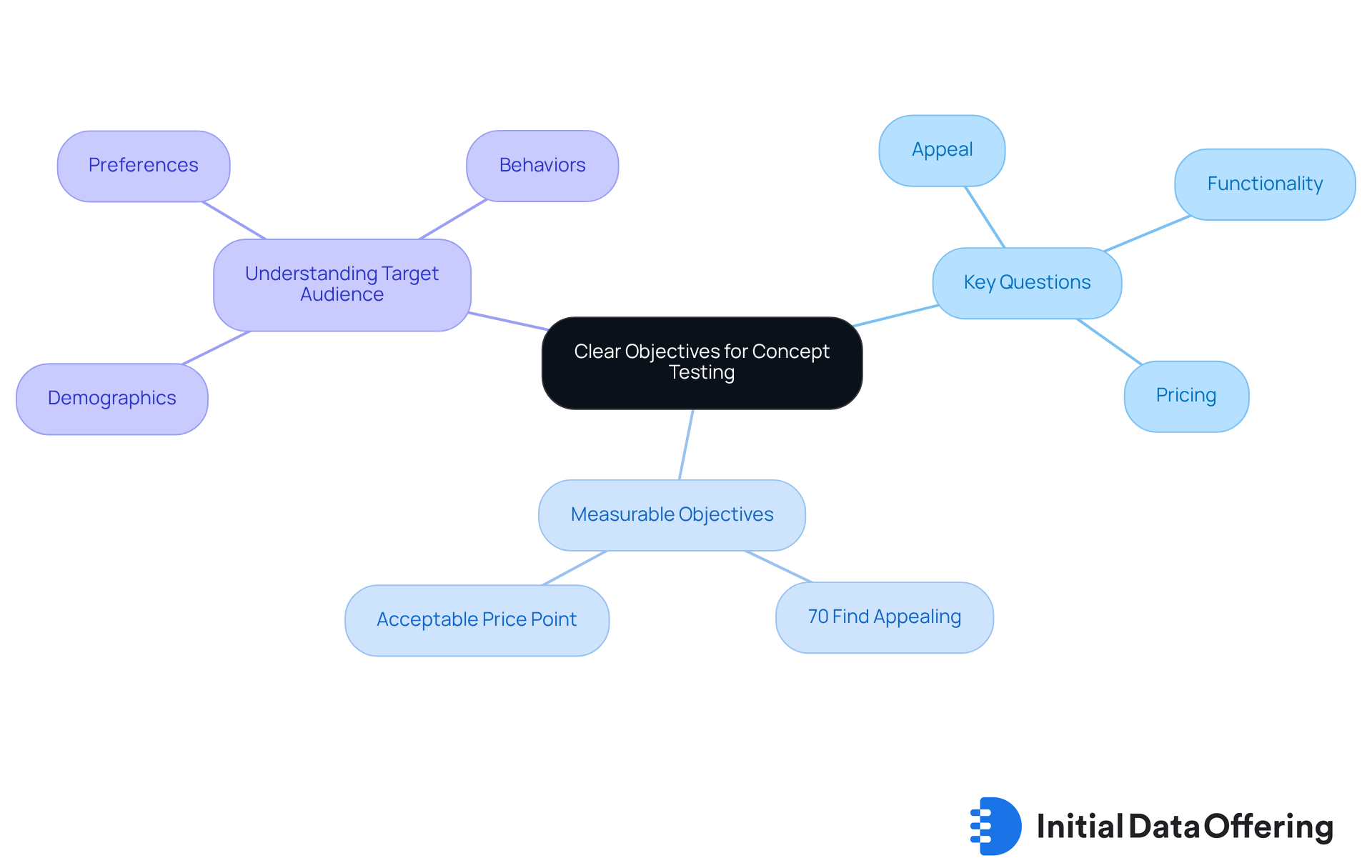
Recruit the Right Participants for Effective Feedback
To effectively recruit participants, it is essential to start by clearly identifying your target audience based on relevant demographics, behaviors, and preferences that align with your idea. Utilizing a variety of recruitment methods—such as online surveys, social media outreach, and collaborations with market research firms—can significantly broaden your reach. Furthermore, consider engaging with online forums and interest groups; these platforms can provide a substantial pool of potential participants. However, be mindful that the influence of dominant group members may dilute the quality of feedback.
It is crucial that your recruitment criteria are tailored to your specific objectives. This ensures that the selected participants can offer meaningful feedback. Offering incentives can enhance participation rates, increasing the likelihood of gathering valuable insights that accurately reflect the perspectives of your target market. Additionally, maintaining ethical standards throughout the recruitment process is vital for establishing credibility.
This strategic approach not only enhances the reliability of your concept testing results but also fosters a deeper understanding of consumer behavior. Ultimately, this understanding can steer more informed decision-making. How can you apply these strategies to refine your own recruitment process?
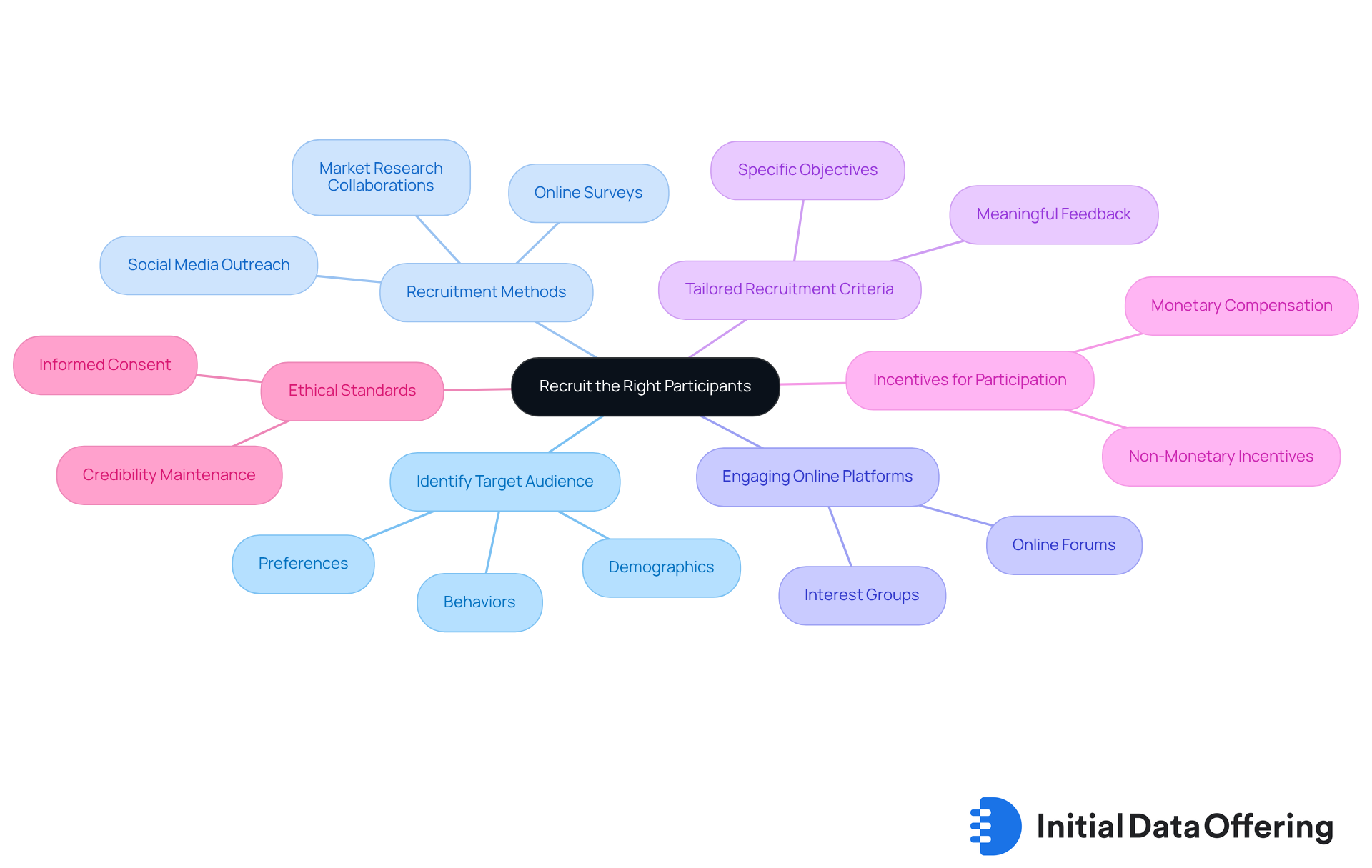
Prepare Your Concepts and Outline the Testing Flow
Begin by clearly outlining the ideas you wish to evaluate for concept testing. Visual aids or prototypes can significantly enhance participant understanding; after all, visuals are processed 60,000 times faster than text and can improve retention rates by up to 400%. Balancing colors and shapes in your visual aids can further enhance comprehension and engagement.
Following this, outline the testing flow by detailing how the concept testing session will proceed. This may involve:
- An introduction
- Idea presentation
- Feedback collection
- A closing discussion
A logical sequence not only promotes smoother interactions but also fosters deeper involvement with the ideas in concept testing. Studies suggest that concept testing through a well-organized evaluation session can result in improved quality feedback, as participants are more inclined to express their ideas when they can visualize the topics being discussed. For instance, students using animated explanations improved test scores by 42% compared to text-only learning groups.
By emphasizing clarity and involvement through efficient visual tools and a logical assessment framework, you can optimize the understanding obtained from your testing sessions.
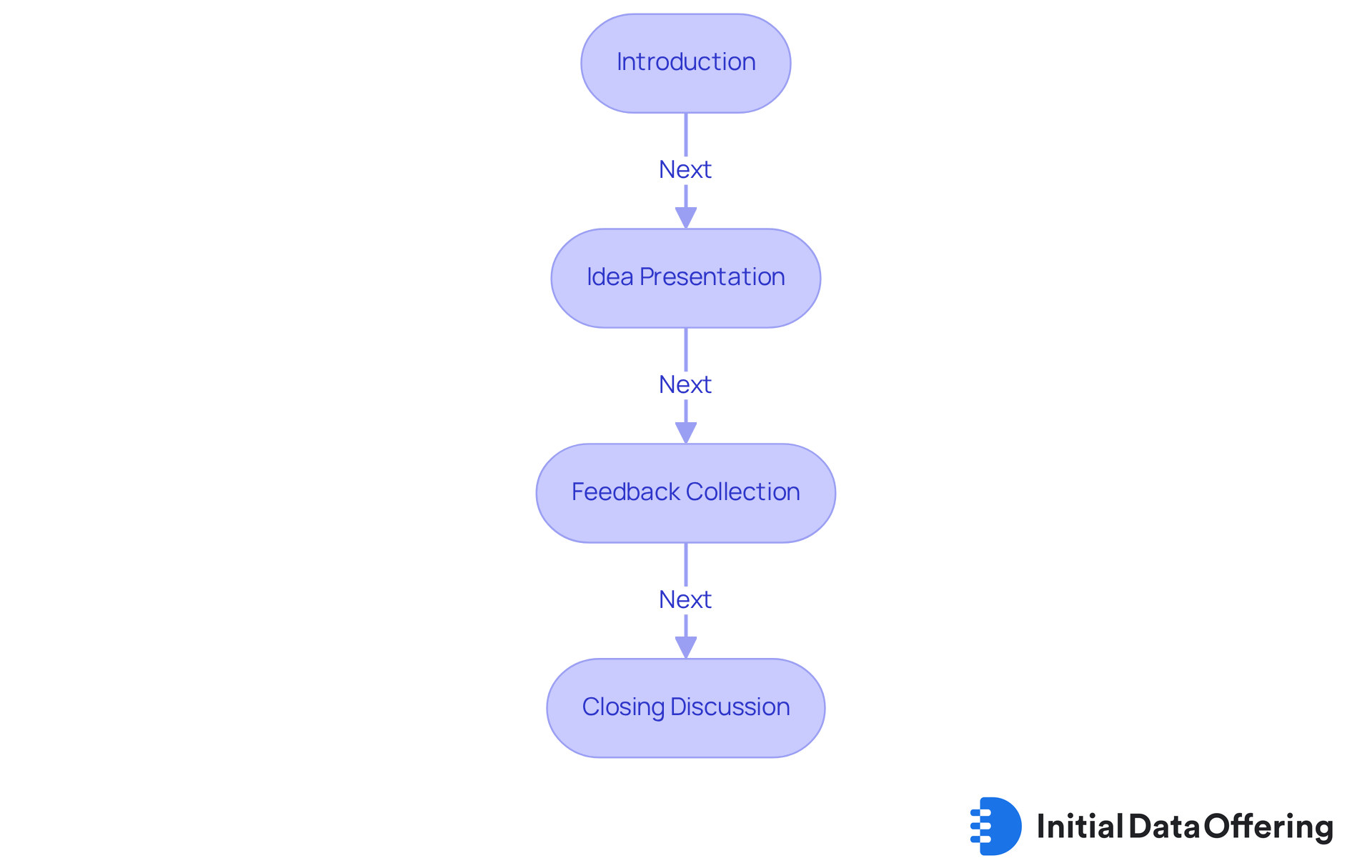
Craft Targeted Questions for Participant Feedback
When engaging in concept testing, it is essential to prioritize clarity and specificity in the questions for participant feedback. This approach enhances the quality of understanding. A balanced mix of open-ended and closed-ended questions should be employed to capture both qualitative and quantitative data. For instance, participants can be asked to rate the idea's appeal on a 1 to 10 scale, utilizing the 5-point Likert Scale to gauge their preferences. Following this, an open-ended question can invite them to elaborate on what they liked or disliked. This dual approach not only quantifies preferences but also utilizes concept testing to reveal deeper insights into participant perceptions.
Aligning your questions with previously established objectives is crucial. It ensures that the data collected is relevant and actionable. As Steve Wigmore highlights, comprehensive idea development and concept testing are essential for product innovation and brand expansion. Carefully designed questions can significantly improve the depth of perceptions, ultimately resulting in a more thorough comprehension of consumer attitudes and preferences. Furthermore, evaluating principles alongside comparable alternatives can offer valuable insight and confirmation for pursuing or modifying ideas.
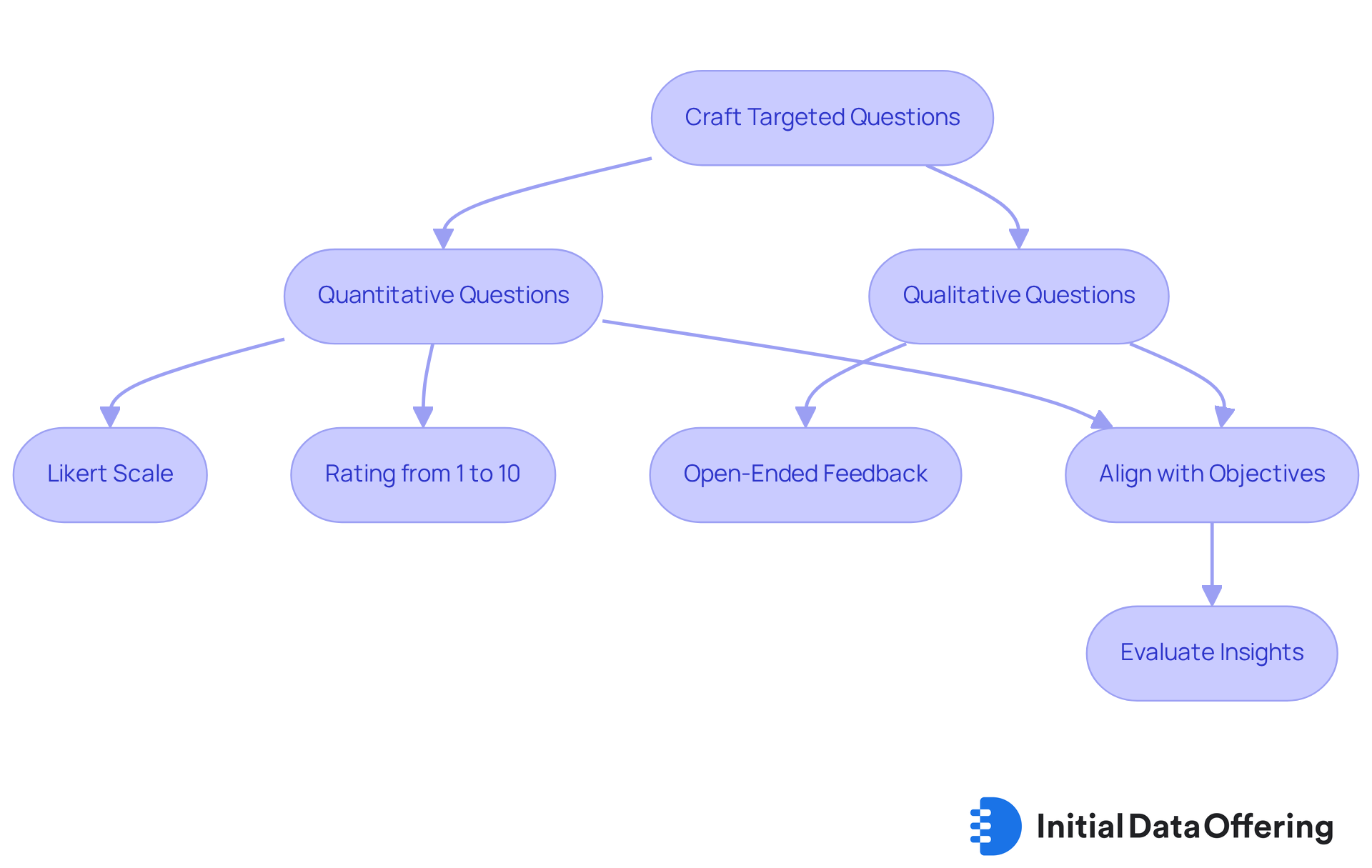
Synthesize Data and Analyze Results for Insights
After collecting feedback, the next step is to synthesize the data effectively. Begin by organizing responses according to the questions posed; this approach aids in identifying patterns and trends within the feedback. For quantitative data, employing statistical analysis techniques such as averages, percentages, and correlations is essential for extracting valuable insights. Common statistical tests, like t-tests and ANOVA, prove particularly useful in comparing different groups or responses. For instance, t-tests assess differences in a quantitative variable between two values of a categorical variable, while ANOVA examines mean differences across three or more groups. For qualitative feedback, categorizing comments reveals recurring themes and sentiments.
Once the data is synthesized, it is crucial to analyze the results in relation to your objectives. What insights can be gleaned that indicate whether the idea aligns with market demands? Identifying areas for improvement is equally important. This comprehensive analysis not only clarifies the viability of the idea through concept testing but also informs strategic decisions regarding its potential launch. By leveraging both quantitative and qualitative insights, marketers can ensure their concept testing resonates with target audiences, ultimately driving successful product introductions. As Christian Vandever notes, understanding significance levels and power is vital in this process, especially considering that 95% of new products introduced each year fail to make a lasting impact on the market. Utilizing tools like Nexis+ AI can streamline this research process, enhancing the efficiency of data analysis.
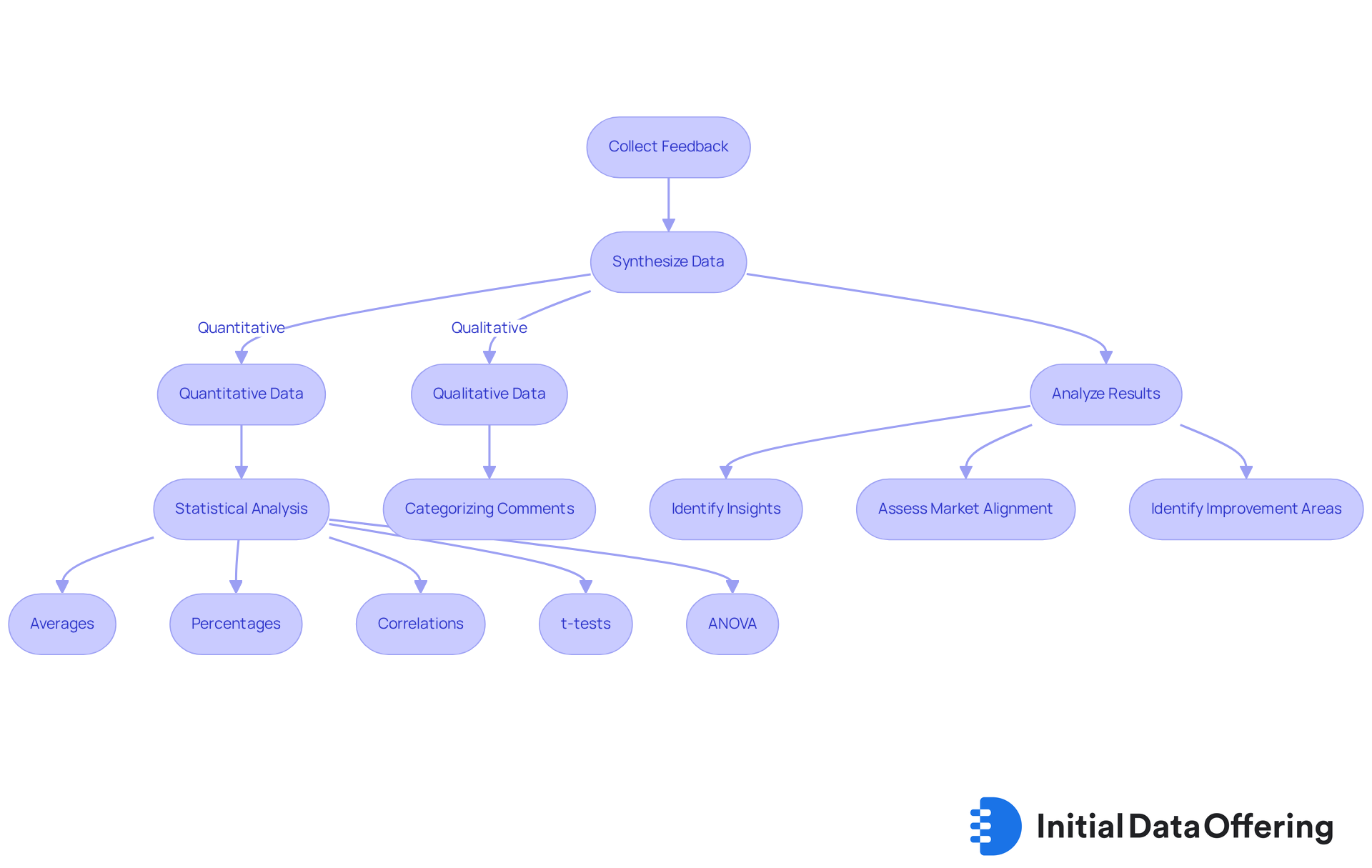
Conclusion
Concept testing is an essential process that empowers businesses to refine their product ideas and marketing strategies before they reach the market. By engaging potential buyers early in the development phase, companies can mitigate risks and enhance their understanding of consumer preferences. This ultimately leads to more successful product launches, showcasing the vital role of concept testing in the product development lifecycle.
The article outlines five critical steps for effective concept testing:
- Defining clear objectives
- Recruiting the right participants
- Preparing concepts thoughtfully
- Crafting targeted feedback questions
- Synthesizing data for actionable insights
Each step emphasizes the importance of aligning testing efforts with consumer needs and market trends. This alignment ensures that the feedback gathered is both relevant and impactful, providing a solid foundation for informed decision-making.
Incorporating these strategies into the concept testing process not only increases the likelihood of a successful product introduction but also fosters a deeper connection with the target audience. By prioritizing consumer insights and adapting to their preferences, businesses can navigate the competitive landscape more effectively. Embracing the significance of concept testing is vital for any organization aiming to innovate and thrive in today’s dynamic market environment. How can your organization leverage these insights to enhance its product development strategy?
Frequently Asked Questions
What is concept testing and why is it important?
Concept testing is a research technique used to evaluate new product proposals or marketing strategies before their launch. It involves gathering feedback from prospective buyers to assess perceptions, preferences, and purchase intentions. Its importance lies in mitigating risks associated with product introductions and providing insights into buyer behavior and market trends.
What are the consequences of neglecting concept testing before a product launch?
Research indicates that 85% of product introductions fail when companies do not engage their audience beforehand. This highlights the critical role of concept testing in refining ideas to increase the chances of a successful market entry.
How have advancements in idea evaluation methods impacted concept testing?
Recent advancements, such as Ipsos' digital idea assessment approach, have improved how companies gather client perspectives. This method allows for more engaging feedback processes, resulting in over 50% more time spent reviewing concepts and enabling outreach to a broader range of demographics, including hard-to-reach groups like Millennials.
What role does AI play in modern concept testing?
The integration of AI in idea evaluation has streamlined the analysis of consumer insights, making decision-making faster and more efficient. For instance, Zappi's AI agents can reduce resource costs for new ideas significantly, demonstrating the effectiveness of contemporary methodologies.
What are the benefits of conducting concept testing?
Concept testing helps reduce risks associated with new product launches and enhances market positioning by identifying strengths and weaknesses early in the development phase. This proactive approach increases the likelihood of successful launches and fosters a deeper understanding of buyer behavior.
How can companies ensure they gather relevant and actionable insights during concept testing?
Companies should establish clear objectives for their concept tests by identifying key questions they want to answer, such as the idea's appeal, functionality, or pricing. Formulating specific, measurable objectives will guide the research and help evaluate the success of the idea.
What is the significance of early concept testing in product development?
Research from Bain & Company shows that brands that utilize concept testing and optimize early are 1.5 to 2 times more likely to achieve successful product launches, emphasizing the necessity of early testing in the development process.
What steps should be taken to ensure effective surveys in concept testing?
It is crucial to test and refine surveys with a small group before full distribution to guarantee clarity and effectiveness in the survey process. This helps ensure that the questions are relevant and resonate with the target audience.